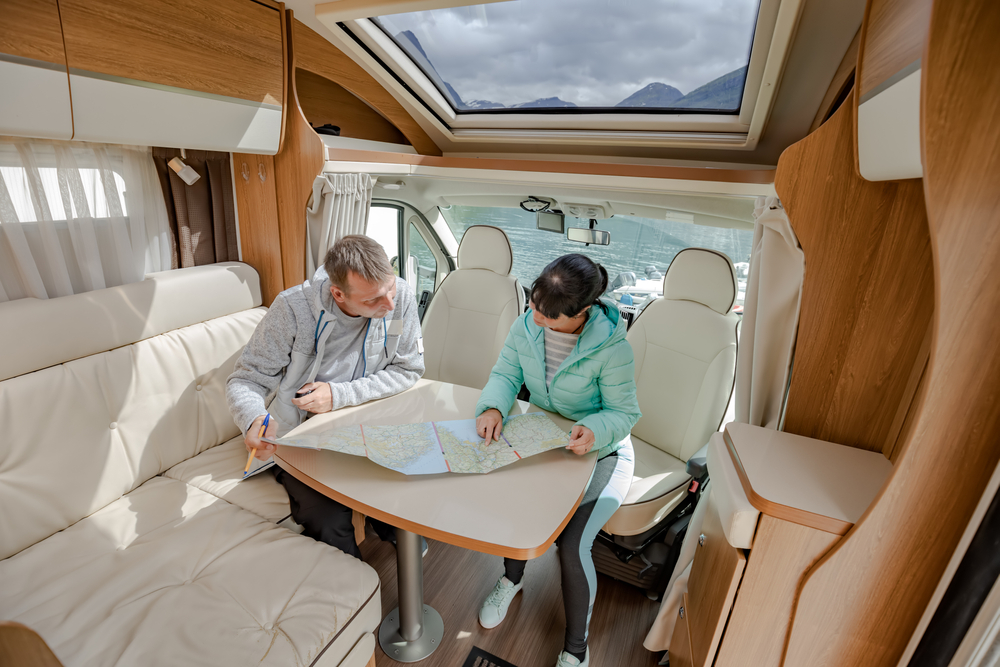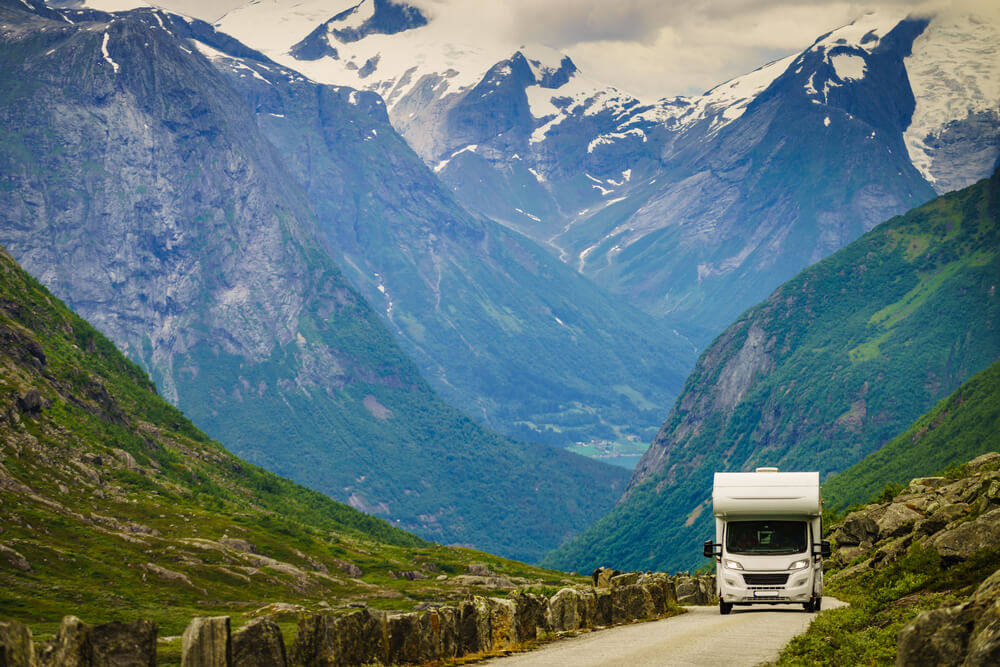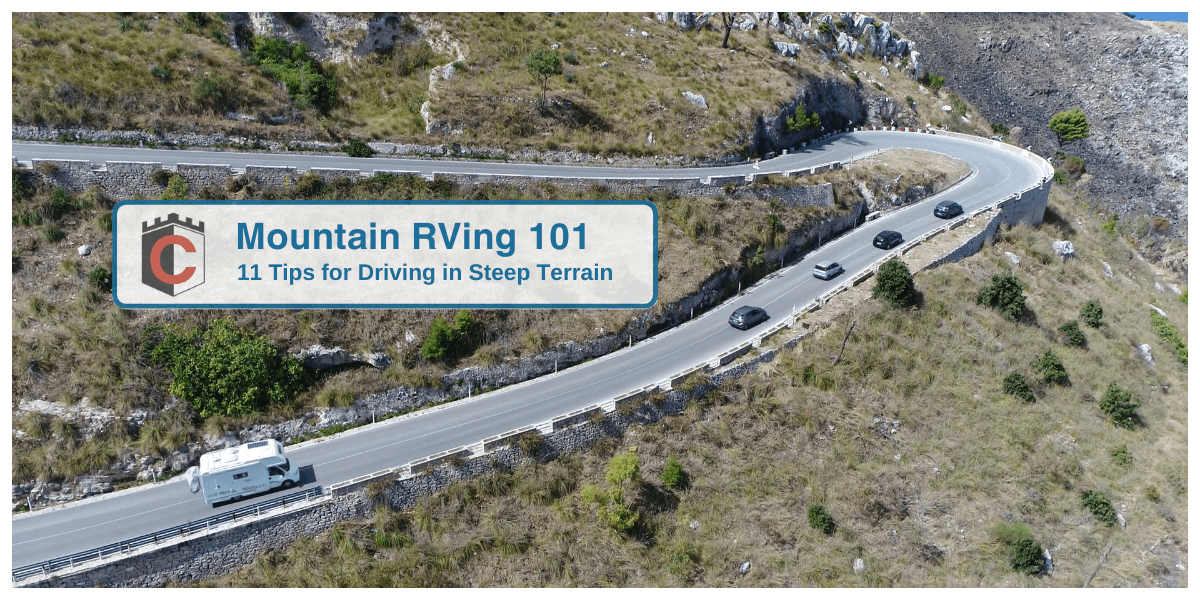Navigating steep mountain roads can be challenging in any motor vehicle, but they can be especially scary for RVers. Generally speaking, when it comes to driving through mountainous terrain, the bigger the vehicle, the trickier the drive can be. Steep climbs are notoriously rough on RV engines, and intense descents can quickly wear out brakes.
The good news is that there are safe ways to navigate peaks, passes, and switchbacks in your RV, so you and your crew won’t have to miss out on fantastic mountain views. High-altitude RV driving is not for everyone, but if you’re cautious and don’t mind sacrificing speed for safety, you’ll be rewarded with stunning scenery and a trip to remember. Here are some of our top tips for smart mountain navigation in your RV.
11 Tips for Driving an RV in Steep Terrain
1. Do Your Homework
Though published in 2006, the Mountain Directory West for Truckers, RV and Motorhome Drivers and the corresponding Mountain Directory East are still super helpful if you’ve got mountain ambitions for your RV crew. These guides describe every mountain pass in detail: turns, grades, the distance at each grade, wide shoulder and steep dropoff alerts, and more. You can also ask fellow RVers online for their thoughts on a particular road or locale: try RV Forum, for starters. You can also find a lot of mountain-driving wisdom for motorhomes and RVs online, like this smart article or this one.
2. Make Sure Your Rig Is in Tiptop Shape
Before you take on a mountain adventure with your RV crew, have your brake pads, rotors, and calipers checked by a professional. Also, be sure all your RV’s fluids have been topped off. Proper pre-trip vehicle maintenance is key for a safe RV trip with steep grades.
3. Slow and Steady Wins This Race
Mountain passes require slow speeds — and plenty of patience — when you’re traveling by RV. Nerves of steel help too! Ignore anyone who honks or attempts to pass unsafely. There are always “not so patient” drivers on the road, but you don’t have to be one of them. Road rage can be especially deadly on narrow, unforgiving mountain passes. Keep your head down and maintain a safe, slow pace. Most drivers will expect RVs to move more slowly.
4. Factor in a Snail’s Pace When Planning Your Travel Days
Keep in mind that your Google Maps ETA will be off if you’re traveling by RV. On days with lots of steep climbs, leave yourself several hours of extra time to navigate between Point A and Point B. Better yet, create shorter itineraries for the days when you’re driving in mountainous terrain. Mountain driving takes more mental energy than you might expect! Do yourself a favor and make sure you’re not trying to go too far or see too much in one day. You and your RV engine will benefit from rest. We are big fans of the RV 3-3-3 rule for any adventure, but especially mountain excursions.

5. All Hail the Hazard Lights
If you find yourself needing to drive your RV 15 to 30 miles below the speed limit in difficult terrain, pop on those hazard lights as a safety precaution. It’s a smart way to give a heads-up to other drivers, especially if weather conditions aren’t great.
6. Tow/Haul Mode Is Your Friend
Tow/Haul mode assists your transmission with optimal gear shifting on tough roads. This mode can create stronger engine braking, which helps lower the chances of brake pads or brake fluid overheating. Tow/Haul mode also keeps the transmission temperature steady. Be sure to check your RV’s user manual for more info on this mode, as tow/haul works differently in different vehicles.
7. Go Easy on the Brakes
This may feel counterintuitive, as many drivers naturally find themselves “riding” the brakes on steep declines. Unfortunately, this can overheat the brakes and cause malfunctioning. The best way to handle those descents? Drive very slowly and try to hold the brake pedal down for no more than 15-20 seconds at a time. Short bursts of braking are the way to go. Remember: Brakes need breaks to work at top capacity.

8. Downshift Before Ascending or Descending
Downshifting is your best friend when you’re tackling mountain roads in an RV. Downshift before you head up a fresh hill — a lower gear provides the extra oomph you’ll need going up.
You’ll also want to downshift if you’re heading down a big hill. Some RVs automatically downshift before a descent, but if yours doesn’t, a steady press on the brakes will nudge your transmission into a lower gear. Descending in a lower gear will allow the engine to take on some braking so your brakes don’t get overworked.
9. Keep Your (Engine) Cool
Consider switching off your A/C on your way up a big climb so your RV engine isn’t working extra hard. You can also run the heat on max force to pull heat from the engine. Sweaty passengers may complain at first, but you can just tell them they’d be complaining a lot more if your RV broke down mid-mountain pass.
10. Overheating? Don’t Turn Off the Engine
If you’re in an overheating situation with your RV, definitely pull over as far as you can on the side of the road, but don’t make the mistake of turning off the engine. The engine needs to idle for antifreeze to circulate through the RV’s radiator. Another counterintuitive measure: As the RV engine idles, turn the heat on with maximum fan going. It will suck heat from the engine and help it to cool down faster.
11. When in Doubt, Find a Less Precarious Route

If your hair is standing on end and your stomach is in knots, listen to your body and plan a different route. There’s no shame in coming up with a new plan to avoid treacherous terrain if you’re feeling anxious. That’s the joy of RV travel — you can switch up plans as needed with your home on the road. Have fun, and take it easy! Your passengers (and your RV engine) will thank you.
At Castle RV, we love hearing about our clients’ adventures. Share your photos, videos, and stories with us on Instagram or Facebook! Are you interested in RV and boat storage options? Give us a call at 720-703-9861 or email us at info@castlerv.com for more information from one of our friendly, knowledgeable staff members. We look forward to making your life easier with our RV and boat storage options in Colorado!


